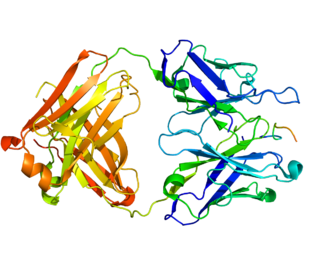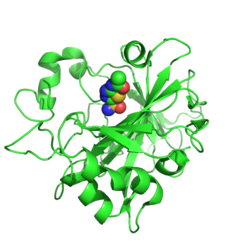
Carbonic anhydrase IX is an enzyme that in humans is encoded by the CA9 gene. It is one of the 14 carbonic anhydrase isoforms found in humans and is a transmembrane dimeric metalloenzyme with an extracellular active site that facilitates acid secretion in the gastrointestinal tract. CA IX is overexpressed in many types of cancer including clear cell renal cell carcinoma (RCC) as well as carcinomas of the cervix, breast and lung where it promotes tumor growth by enhancing tumor acidosis.

Carbonic anhydrase 12 is an enzyme that in humans is encoded by the CA12 gene.

Carbonic anhydrase 6 is an enzyme that in humans is encoded by the CA6 gene. It is also called 'gustin' because of its presence in saliva, and lower-than-normal levels of salivary zinc in individuals with hypogeusia.

Serine protease 23 is an enzyme that in humans is encoded by the PRSS23 gene.

Tetraspanin-13 is a protein that in humans is encoded by the TSPAN13 gene.

Carbonic anhydrase-related protein 10 is an enzyme that in humans is encoded by the CA10 gene.

Cysteine-rich with EGF-like domain protein 1 is a protein that in humans is encoded by the CRELD1 gene.

Transmembrane protein 50A is a protein that in humans is encoded by the TMEM50A gene.

Transmembrane protein 130 is a protein that in humans is encoded by the TMEM130 gene.

Ubiquitin-like protein 3 is a protein that in humans is encoded by the UBL3 gene.

Allograft inflammatory factor 1-like is a protein that is encoded by the AIF1L gene in humans.

Netrin-G2 is a protein that in humans is encoded by the NTNG2 gene.

Fibroblast growth factor 17 is a protein that in humans is encoded by the FGF17 gene.

Carbonic anhydrase 5B, mitochondrial is an enzyme that in humans is encoded by the CA5B gene.

Thioredoxin-related transmembrane protein 1 is a protein that in humans is encoded by the TMX1 gene.

Lipoma HMGIC fusion partner-like 1 protein is a protein that in humans is encoded by the LHFPL1 gene.

Keratinocyte differentiation-associated protein is a protein that in humans is encoded by the KRTDAP gene.

Claudin domain-containing protein 1 is a protein that in humans is encoded by the CLDND1 gene.

Serine incorporator 1 is a protein that in humans is encoded by the SERINC1 gene.

Long-chain fatty acid transport protein 3 is a protein that in humans is encoded by the SLC27A3 gene.



















